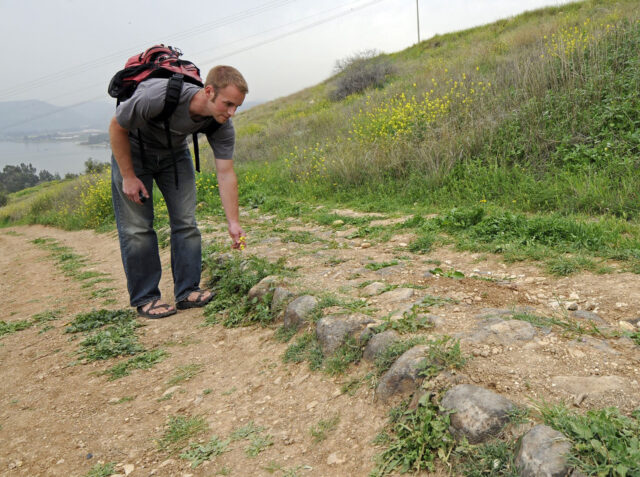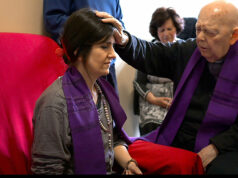
So many significant moments in my spiritual life are tied to sights, smells, sounds and emotions felt on a pilgrimage: The deep sigh after walking all the way up from the train stop to the Basilica of St. Francis of Assisi. My jaw dropping when I turned the corner and saw St. Peter’s Square. Squatting and praying at the Sea of Galilee shortly after my grandmother passed away.
There are a billion reasons why you might go on a pilgrimage: to get away or to come home; to find yourself or to find God. Although Jesus lived his life in a relatively small geographical radius, Christians — since Constantine’s mother, Helena, made her own trip to Jerusalem — have always made pilgrimages.
They’ve gone to tombs of martyrs, sites of Marian apparitions, as well as the place that Jesus walked. Pope Francis has said that going on pilgrimage is “one of the people of God’s most eloquent expressions of faith.”
Why? And why should Catholics today try to go on one as often as possible?
First, it reminds us that our very lives are a pilgrimage. Our homes are in this world, but we are only here temporarily. Even within our four walls and our hometowns, we are guests on this Earth. And while a pilgrimage on a pilgrimage might seem a little meta, it does remind us that we should live our lives as if we are merely travelers passing through.
Second, it reminds us that the world and the church are bigger than what we’ve known thus far. It expands our ideas of both time and space. Pilgrimage sites tend to draw faithful people from all over the world.
I remember the first time I attended a Wednesday papal audience and saw the multitude of flags and languages around me. It left quite an impression on what a global church means on a young Catholic. We also typically visit graves and sites and say prayers that are centuries older than we are — reminding us that our faith has been handed down to us, that we belong to a communion outside of our present age.
Third, like a retreat, pilgrimages allow us to step outside of the regular churn of productivity to destabilize us enough that we might actually hear God’s voice. Yet unlike a retreat, it requires that we be on the move, giving us practice at becoming contemplatives in action.

But how does someone make a pilgrimage? There are a few tips to keep in mind and questions to consider when discerning making a pilgrimage
Where should you go? This depends on your time and budget, mostly. The Holy Land, Rome, the Camino de Santiago, Guadalupe — those and a few others are heavy hitters for a reason and, if possible, everyone should try to do one of them once in their lifetimes.
But you don’t need to travel to another country or get on a plane. According to the University of Dayton, there are Marian shrines in 37 U.S. states. You could even make a pilgrimage in your hometown. Are there places in your family or community that have spiritual resonance and a connection to the past? Schedule an intentional day to travel there — maybe on foot or by scenic route — and spend some quiet reflective time there.
A pilgrimage is not a vacation (but that doesn’t mean it isn’t relaxing or fun). As Pope Benedict XVI said, “To go on pilgrimage is not simply to visit a place to admire its treasures of nature, art or history.” Rather, it “really means to step out of ourselves in order to encounter God where he has revealed himself, where his grace has shone with particular splendor.”
As a result, you’ll want to approach it differently than you would your typical vacation. Pack simply and lightly. Manage your expectations: Something will probably go wrong.
The site, shrine or painting you were most excited to see will be closed for renovation. It will rain on the day you arrive. Your bad knee will act up at the worst possible time. A good pilgrim is an adaptable one who realizes that all these things are part of the pilgrimage you were supposed to be on.
Ask God for a specific grace to come from your pilgrimage. You aren’t just going to visit something when you’re on pilgrimage — you’re bringing some things with you. Hopes, fears, anxieties. Call those to mind.
Maybe you have a big life decision coming up. Ask for clarity. Maybe someone in your life is going through a debilitating illness. Ask God to comfort that person. It might seem odd to think about yourself or your home while traveling, but it helps put some of the experience and prayers you’ll go through on pilgrimage into perspective.
Pray to travel with a pilgrim’s heart. Be open to new experiences. Trust in God’s providence and the welcome and kindness of strangers to guide your way. These are good practices for life, but we can do our best to accentuate them on pilgrimages, when we’re somewhat forced to.
Ultimately, pilgrimages help us to see ourselves, our homes and our world with the eyes of God: eyes of wonder, mercy and solidarity. So, what are you waiting for? I’ll see you on the road.
By Zac Davis, Catholic News Service
Zac Davis is an associate editor at America magazine and a co-host of the podcast, Jesuitical. Davis is leading a pilgrimage to Italy this September. To join him, visit selectinternationaltours.com/jesuitical-podcast/ and find out more.






